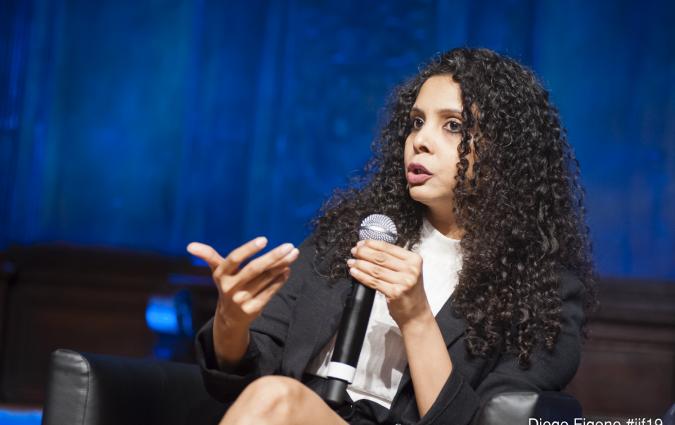In this piece
Navigating malign influence campaigns in the Philippines: a guide for journalists and newsrooms

Washington Post journalist Regine Cabato takes stock of lessons gained during the 2022 Philippine presidential election (Image generated by DALL.E)
In this piece
Journalistic challenges in fractured realities | 1. Cover proposed solutions critically | 2. Be selective about amplification | 3. Deal wisely with influence actors | 4. Pursue a standardised newsroom protocol | Tackling the Hydra | Training resources | Handbooks and guides | Video resources | Online tools and support organisations | Research and booksI was decapitated at Oxford University. At least, that’s what an anonymous sender told my mother in a text message. "She was seen inside her room naked, and her neck was cut off!" they wrote, claiming to be from the Manila Embassy. I blinked at a photo of the message forwarded by my sister. I was wrapped in four layers, but that January morning suddenly felt chillier.
On instinct, I looked around the uncrowded bus cruising on the way to London. After determining there was no threat from the elderly couple near the door, I let myself feel the shock first… and then the laughter. ‘A head is cut off,’ I thought, ‘not a neck.’
When I began my fellowship at the Reuters Institute in the autumn of 2022 – exhausted by marathon coverage of a disinformation-riddled election in my home country – I kept a low profile in the hope harassment wouldn’t follow me.
In the Philippines, a colourful archipelago of some 100 million people just west of the Pacific, a young and digitally savvy population has helped power a growing digital economy that includes call centres, platform gig work, and an underground industry of disinformation and influence operations.
The country is one of the world’s most chronically online nations and has earned the moniker of “patient zero” of the post-truth era. In 2016, it elected Rodrigo Duterte: a gun-toting, tough-talking populist whom the Oxford Internet Institute discovered spent a whopping PhP 10 million – or $200,000 – on a keyboard army to sway the electorate. The Philippines was widely seen as a precedent and branded a testing ground – a “petri dish” – for disinformation tactics that would be exported around the world.
What Duterte began in 2016 was perfected a presidency later. Ferdinand Marcos Jr., son and namesake of a dictator who plundered up to $10 billion from the country, emerged the victor of the 2022 presidential election. The win came on the back of an extensive online and offline campaign to whitewash his family history. His running mate, Vice President Sara Duterte-Carpio, was Duterte’s daughter.
Marcos has denied using troll farms, but data shows evidence of coordinated, manipulated networked propaganda surrounding much of his online support. He was the biggest beneficiary of disinformation, while opposition candidate Leni Robredo was its biggest target. In January 2022, Twitter suspended hundreds of pro-Marcos accounts for violating rules on spam and manipulation. And his support base dominates Facebook and YouTube, with eight out of ten videos on the latter platform seeking to rewrite the Marcos family’s history.
The propaganda network has become so encompassing that it’s almost impossible to tell the inauthentic from the organic. “Perception is real,” Imelda Marcos herself said in Lauren Greenfield’s 2019 documentary The Kingmaker, “and the truth is not”.
Journalistic challenges in fractured realities
For journalists reporting from the Global South, especially those lacking the data analysis and OSINT teams of larger Western outlets, countering disinformation poses unique challenges. The changing psyche of the Philippine public, both on- and offline, requires a realistic guide for colleagues navigating the complex landscape.
To create that resource, I delved into journalists' experiences during the 2022 campaign, compiled lessons, and drew insights from foreign reportage on similar themes. Conversations with 22 journalists covering the Philippine election and disinformation ecosystem, along with interviews with a political strategist and insights from academics, shed light on the intricate web of information warfare. For a more detailed guide, find the PDF attached below. Here, I’ve summarised four recommendations for improving coverage of malign influence operations, and list additional resources in a sidebar below.
1. Cover proposed solutions critically
Evaluate policy interventions and solutions critically, considering public policy oversight and market-shaping initiatives.
Be cautious about self-regulation in regions where fake news laws can be weaponised against freedom of speech.
While it helps to keep abreast of international developments and interventions on influence and what it could mean for the Global South, but it’s also important to focus on bridging gaps and depolarising communities.
2. Be selective about amplification
Move towards "strategic amplification" and recognise the costs and consequences of information dissemination.
Wean off over-reliance on visual tools like "quote cards" that can be easily manipulated.
Carefully choose programme guests and sources to avoid amplifying disinformers and bad faith actors unchecked.
3. Deal wisely with influence actors
Approach manipulative actors critically, considering the necessity of their voice in the story.
Conduct thorough research to assess characters’ positions and motivations, distinguishing between state and private actors.
Differentiate reportage approaches based on the story angle, maintaining a balance between confidentiality and accountability.
4. Pursue a standardised newsroom protocol
Establish a clear protocol for journalists targeted by malign influence campaigns, treating online abuse as a significant concern.
Track and document attacks against the company and employees, providing regular security assessments, tools, and training.
Institute a welfare protocol offering support such as leave, psychological first aid, legal counselling, and more.
Tackling the Hydra
Malign influence campaigns, akin to a hydra, have transformed from obviously inauthentic schemes into well-funded, well-oiled machines. Cutting one head only sees more growing in its place. The challenge for journalists navigating this intricate web lies in understanding the evolving tactics of influence campaigns and adapting strategies to counter them effectively.
Training resources
- Verification Handbook 3: For Disinformation And Media Manipulation by EJC
- Digital Forensic Research Lab training by Atlantic Council
- A Handbook for Journalism Education and Training by UNESCO Journalism, ‘Fake News’ and Disinformation
- FIMI: Towards a European Redefinition of Foreign Interference, EU Disinfo Lab
Handbooks and guides
- CPJ Digital Safety Guide https://cpj.org/2020/05/digital-safety-protecting-against-targeted-online-attacks/
- Protecting Newsrooms and Journalists Against Online Violence by IWMF
- The Philippine Journalists’ Safety Guide (2020), has a chapter dedicated to digital and information security, with a few tips for online harassment
- UNESCO’s The Chilling: what more can news organisations do to combat gendered online violence?
- The Media Manipulation Casebook
- 10 Tips for Reporting on Disinformation from Data & Society
- CPJ Digital Safety Working from Home
Video resources
- Craig Silverman on Exposing the people and funding behind websites and digital ads
- Jane Lytvynenko and Craig Silverman on Investigating media manipulation campaigns
Online tools and support organisations
- The Breakout Scale: Measuring the Impact of Influence Operations by Brookings
- The DISARM (DISinformation Analysis and Risk Management) framework
- Reporters Without Borders’ forensic services for digital attacks on journalists
- Coalition Against Online Violence: https://onlineviolenceresponsehub.org/
Research and books
- Disinformation 2.0: Trends for 2021 and beyond by the European Centre of Excellence for Countering Hybrid Threats
- Harvard Kennedy School’s Misinformation Review
- How to Be a Woman Online: Surviving Abuse and Harassment, and How to Fight Back, by disinformation expert Nina Jankowicz, published in 2022, contains practical tips for digital security and fostering safe spaces.
This project and fellowship have been made possible by the support of the Thomson Reuters Foundation.



